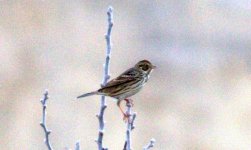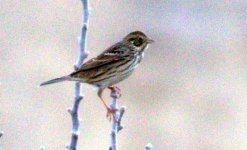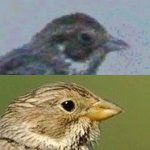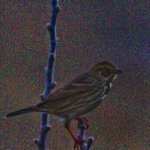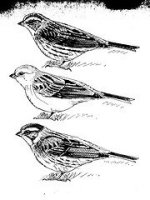-
Welcome to BirdForum, the internet's largest birding community with thousands of members from all over the world. The forums are dedicated to wild birds, birding, binoculars and equipment and all that goes with it.
Please register for an account to take part in the discussions in the forum, post your pictures in the gallery and more.
You are using an out of date browser. It may not display this or other websites correctly.
You should upgrade or use an alternative browser.
You should upgrade or use an alternative browser.
Mystery bunting - Turkey (1 Viewer)
- Thread starter alazzo
- Start date
More options
Who Replied?lewis20126
Well-known member
The more I check this pic on my phone the more I believe it's a Corn Bunting...
This was my conclusion last night but thought I must be missing something..
cheers, alan
Rotherbirder
Well-known member

The more I check this pic on my phone the more I believe it's a Corn Bunting...
FWIW, I'm inclined to agree! From Little to Corn in several stages; just goes to show the folly of trying to identify to species from less-than-ideal images I suppose - assuming it is Corn Bunting of course!!
RB
Last edited:
RafaelMatias
Unknown member

Another one for Corn Bunting. Besides what other people have said, the proportions were wrong for Little (head is tiny and the bill is huge, regardless of shape).
Where is the strong and yellowish beak of corn bunting? Where is the pure and one-colored forehead? Where is the two white wing bars -as you can see at Photo- at corn bunting? This bird has not too much spots on its breast as corn bunting. I dont think that is a corn bunting. Sorry.
I've been looking at this thread just to learn something.
However, I can't understand why no-one has tried to improve the photo to get more detail.
So, I attach an improved-contrast version of the photo, and an enlarged version of this.
For myself, the chest streaking looks rather long (stripes not small streaks) and dark (basically black not brown) for Little or Pine (and other contrasts look wrong, too). Corn Bunting looks better for me, as some have said (the Wikipedia photo of Corn Bunting looks just like this bird). The original photo isn't good enough in my opinion to make comments about the bill colour as alazzo tries to do; it was obviously taken in a strange light.
(But I have very little experience of any of these. Mainly I want to make the point about photo improvement. The original photo makes any conclusion difficult, and a bit of legitimate adjustment gives more information to work with in my opinion.)
However, I can't understand why no-one has tried to improve the photo to get more detail.
So, I attach an improved-contrast version of the photo, and an enlarged version of this.
For myself, the chest streaking looks rather long (stripes not small streaks) and dark (basically black not brown) for Little or Pine (and other contrasts look wrong, too). Corn Bunting looks better for me, as some have said (the Wikipedia photo of Corn Bunting looks just like this bird). The original photo isn't good enough in my opinion to make comments about the bill colour as alazzo tries to do; it was obviously taken in a strange light.
(But I have very little experience of any of these. Mainly I want to make the point about photo improvement. The original photo makes any conclusion difficult, and a bit of legitimate adjustment gives more information to work with in my opinion.)
Attachments
Bryon Wright
Well-known member
Bunting
Hi,
a long time since I looked but Pine Bunting is virtually the only bunting with continuous, dark cherry red, flank markings. Corn Bunting has lighter and smaller flank markings? Enclose ten year old Uzbekistan sketch. Think the top bird is supposed to be Pine!
Hi,
a long time since I looked but Pine Bunting is virtually the only bunting with continuous, dark cherry red, flank markings. Corn Bunting has lighter and smaller flank markings? Enclose ten year old Uzbekistan sketch. Think the top bird is supposed to be Pine!
Attachments
Nutcracker
Stop Brexit!
Look at this one. Just decreased brightness and increased contrast values. White tip emerged on tail. Which corn bunting has white tip on tail?
So does the twig have white edges - it's just background light catching the edges, so isn't relevant to the ID.
I'd be more concentrating on the grey lesser coverts and the fairly small bill, neither of which fit well for me for Corn Bunting. Not sure what it is, though.
So does the twig have white edges - it's just background light catching the edges, so isn't relevant to the ID.
I'd be more concentrating on the grey lesser coverts and the fairly small bill, neither of which fit well for me for Corn Bunting. Not sure what it is, though.
You can check the white tips on tail from original photo carefully. I can see. You can too.
Hi everyone,
Years ago (in 1991) I photographed a pine bunting at the exact same location. I was studying the birds of METU (Middle East Technical University) campus, using transect and point count methodology for an entire period of 1.5 years. Every week once or twice per week. Although the study report was signed by 28 people, only a few person did not missed any field work during this study and I was one of them (Uygar Özesmi and Aslı Sezer Özçelik (my wife) were the others, who are already the founders of the METU birdwatching club). And now I am living in a place just about the same area (6 km to the point that the bird was photographed ). I should also add, that last year I shoot some lowlight video footage of. Same bird at around Yavrucak village which is about 30 km to the beforementioned location. However I have some suspects about the bird in this photo wheather it is pine or not.
I can roughly say that the pale parts of throat and flanks are not same color. Also The pale lesser coverts fringes are not same color with the pale parts of the flanks of the bird, compared against the illustration you shared in your facebook page (this can not be attrubuted to the light conditions). The white tips of the tail seems caused by the whitish fringes of the tail feathers, which is closed and only white tips are visible from this (side) angle. This detail can also be seen in two or three buntings.
On the other hand, many buntings are not monotipic birds, including Corn Bunting. I mean it has subspecies and in some cases the abovementioned descriptive characters can be misleading. You can find the subspecies descriptions of the buntings in the "Handbook of Western Palearctic-full version" which is available in METU's library, referance division (I remember how we insisted and forced the library to buy the last volumes of this encyclopedia in those years).
Anyway there are at least two subspecies of the Corn bunting in Turkey: Miliaria calandra calandra (Linnaeus, 1758), Miliaria calandra bturlini (Hermann Johansenn, 1907). There are also some middle forms i. e. in Portenko, 1962, which (the last one) today is not valid. There is also color change, and bill size differences, among the bird populations from the western part of the Western Palearctic towards the eastern parts of the region. Please read their descriptions carefully and decide yourself which bird this is. I can judge directly, but you will become some of the best scientists/engineers in Turkey and I believe
You won't base your identifications on shallow informations.
Since recently some Turkish birders described a shrike species as "Turkistan Shrike", although it is obviously a Chinese Shirike. Now a few hundred people in Turkey know this bird wrongly. Normally I don't join such dicussions. But recently, almost every year some wrongly described bird species started to be added to our fauna. That is why, at least I started to make comments and write about my experience and/or expertese to avoid wrong additions of the fauna of Turkey and also to prevent beginners judge me as a "wrong descripter" taking into acount that I have photographed and reported (under the supervision of some of the well known european birders) these birds a quarter century ago
Best..
Murat F. Özçelik
https://vimeo.com/channels/murat
Years ago (in 1991) I photographed a pine bunting at the exact same location. I was studying the birds of METU (Middle East Technical University) campus, using transect and point count methodology for an entire period of 1.5 years. Every week once or twice per week. Although the study report was signed by 28 people, only a few person did not missed any field work during this study and I was one of them (Uygar Özesmi and Aslı Sezer Özçelik (my wife) were the others, who are already the founders of the METU birdwatching club). And now I am living in a place just about the same area (6 km to the point that the bird was photographed ). I should also add, that last year I shoot some lowlight video footage of. Same bird at around Yavrucak village which is about 30 km to the beforementioned location. However I have some suspects about the bird in this photo wheather it is pine or not.
I can roughly say that the pale parts of throat and flanks are not same color. Also The pale lesser coverts fringes are not same color with the pale parts of the flanks of the bird, compared against the illustration you shared in your facebook page (this can not be attrubuted to the light conditions). The white tips of the tail seems caused by the whitish fringes of the tail feathers, which is closed and only white tips are visible from this (side) angle. This detail can also be seen in two or three buntings.
On the other hand, many buntings are not monotipic birds, including Corn Bunting. I mean it has subspecies and in some cases the abovementioned descriptive characters can be misleading. You can find the subspecies descriptions of the buntings in the "Handbook of Western Palearctic-full version" which is available in METU's library, referance division (I remember how we insisted and forced the library to buy the last volumes of this encyclopedia in those years).
Anyway there are at least two subspecies of the Corn bunting in Turkey: Miliaria calandra calandra (Linnaeus, 1758), Miliaria calandra bturlini (Hermann Johansenn, 1907). There are also some middle forms i. e. in Portenko, 1962, which (the last one) today is not valid. There is also color change, and bill size differences, among the bird populations from the western part of the Western Palearctic towards the eastern parts of the region. Please read their descriptions carefully and decide yourself which bird this is. I can judge directly, but you will become some of the best scientists/engineers in Turkey and I believe
You won't base your identifications on shallow informations.
Since recently some Turkish birders described a shrike species as "Turkistan Shrike", although it is obviously a Chinese Shirike. Now a few hundred people in Turkey know this bird wrongly. Normally I don't join such dicussions. But recently, almost every year some wrongly described bird species started to be added to our fauna. That is why, at least I started to make comments and write about my experience and/or expertese to avoid wrong additions of the fauna of Turkey and also to prevent beginners judge me as a "wrong descripter" taking into acount that I have photographed and reported (under the supervision of some of the well known european birders) these birds a quarter century ago
Best..
Murat F. Özçelik
https://vimeo.com/channels/murat
dantheman
Bah humbug
So does the twig have white edges - it's just background light catching the edges, so isn't relevant to the ID.
I'd be more concentrating on the grey lesser coverts and the fairly small bill, neither of which fit well for me for Corn Bunting. Not sure what it is, though.
You can check the white tips on tail from original photo carefully. I can see. You can too.
You can also see the white edges to the twigs in the first photo. Along with the white below the bill and at the back of the upper leg - hence agree this could be an effect of the back lighting (frayed end of tail feathers with light shining through them)?
Not got enough experience of buntings or Turkish races of Corn Bunting to comment further on the actual id though ... although if it can't be made into a Pine Bunting or rare bunting from the east then Corn Bunting becomes the default ... or best left as unidentified?
Heavy flank streaking and dark pink legs in the latest, and indeed, dark breast spot area.
Jane Turner
Well-known member
This Turkish Corn Bunting looks remarkably similar
http://img02.imgfotokritik.com/fk_new/lowres/2/8/6/286054/2134925-tarla-cintesi.jpg
http://img02.imgfotokritik.com/fk_new/lowres/2/8/6/286054/2134925-tarla-cintesi.jpg
CARERY
Well-known member
Hi all,
I just recently joined this forum and immediately found this fascinating discussion. Interesting how difficult buntings can be! The largest and the smallest species have been suggested! Great!
I wonder why no one asked about the size of the bird. That could straight away rule out a few discussed species. Even without comparison of other birds closeby a Corn Bunting should be recognised by it's clearly bigger size. On the other hand Little Bunting should be - well - little!
Admittedly the picture is quite poor, but still shows a few features. Firstly, the upper wingbar is rather prominent and whitish that excludes Reed Bunting. Secondly, the bill is rather weak and so if not already by overall size, Corn Bunting is out (bill should be much stronger and more curved even in the more eastern birds) as is Little Bunting (bill should be even finer, and also ear coverts should be different). Thirdly, flank streaking is not dark red-brown but clearly broad and blackish, so Rustic is out as is another species not yet considered: first year Cirl Bunting.
I think that Pine Bunting indeed is the best guess! At first I thought the whitish upper wingbar would be a problem but look at this picture:
http://rarebirdalert.co.uk/RealData/gallery_show.asp?galleryid=45920&page=1&sort=4&SpeciesID=18560&L1=0
Cheers,
Roland
I just recently joined this forum and immediately found this fascinating discussion. Interesting how difficult buntings can be! The largest and the smallest species have been suggested! Great!
I wonder why no one asked about the size of the bird. That could straight away rule out a few discussed species. Even without comparison of other birds closeby a Corn Bunting should be recognised by it's clearly bigger size. On the other hand Little Bunting should be - well - little!
Admittedly the picture is quite poor, but still shows a few features. Firstly, the upper wingbar is rather prominent and whitish that excludes Reed Bunting. Secondly, the bill is rather weak and so if not already by overall size, Corn Bunting is out (bill should be much stronger and more curved even in the more eastern birds) as is Little Bunting (bill should be even finer, and also ear coverts should be different). Thirdly, flank streaking is not dark red-brown but clearly broad and blackish, so Rustic is out as is another species not yet considered: first year Cirl Bunting.
I think that Pine Bunting indeed is the best guess! At first I thought the whitish upper wingbar would be a problem but look at this picture:
http://rarebirdalert.co.uk/RealData/gallery_show.asp?galleryid=45920&page=1&sort=4&SpeciesID=18560&L1=0
Cheers,
Roland
dantheman
Bah humbug
I'd also considered Yellowhammer too  Presumably that is out too (except if Pine Bunting is in).
Presumably that is out too (except if Pine Bunting is in).
I was going to post but forgot - was the bird observed well, by how many (apols it may have been mentioned). I think there is only one photo of the bird, just it's been manipulated to try and bring out some details.
I was going to post but forgot - was the bird observed well, by how many (apols it may have been mentioned). I think there is only one photo of the bird, just it's been manipulated to try and bring out some details.

Perhaps because people have started realizing that human beings are very poor at judging size of unknown birds.I wonder why no one asked about the size of the bird.
Niels
Edit: secondly because runt individuals to exist that differ in size from others of same species.
Last edited:
Users who are viewing this thread
Total: 2 (members: 0, guests: 2)






